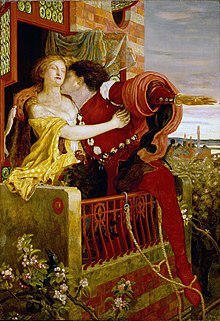Romeo
| Romeo | |
|---|---|
 The balcony scene in Romeo and Juliet as depicted by Ford Madox Brown | |
| Created by | William Shakespeare |
| In-universe information | |
| Family |
|
Romeo Montague (Italian: Romeo Montecchi) is one of the title characters in William Shakespeare's tragedy Romeo and Juliet. He serves as the play's male protagonist. Romeo, the son of Montague and his wife, secretly loves and marries Juliet, a member of the rival House of Capulet. Forced into exile by his slaying of Juliet's cousin, Tybalt, in a duel, Romeo commits suicide upon hearing falsely of Juliet's death.
The character's origins can be traced as far back as Pyramus, who appears in Ovid's Metamorphoses, but the first modern incarnation of Romeo is Mariotto in the 33rd of Masuccio Salernitano's Il Novellino (1476). This story was adapted by Luigi da Porto as Giulietta e Romeo (1530), and Shakespeare's main source was an English verse translation of this text by Arthur Brooke.[1] Although both Salernitano and da Porto claimed that their stories had historical basis, there is little evidence that this is the case.
Romeo, an only child like Juliet, is one of the most important characters of the play, and has a consistent presence throughout it. His role as an idealistic lover has led the word "Romeo" to become a synonym for a passionate male lover in various languages. Although often treated as such, it is not clear that "Montague" is a surname in the modern sense.
Origins
The earliest tale bearing a resemblance to Shakespeare's Romeo and Juliet is Xenophon of Ephesus' Ephesiaca, whose hero is a Habrocomes. The character of Romeo is also similar to that of Pyramus in Ovid's Metamorphoses, a youth who is unable to meet the object of his affection due to an ancient family quarrel, and later kills himself due to mistakenly believing her to have been dead.[2] Although it is unlikely that Shakespeare directly borrowed from Ovid while writing Romeo and Juliet, the story was likely an influence on the Italian writers who the playwright was greatly indebted to.[3] The two sources which Shakespeare most likely consulted are Brookes' translation of de Porta and W. Painter's The goodly historye of the true, and constant Love between Romeo and Juliet.[1]
References
Bibliography
- Bevington, David M. (2006). How to read a Shakespeare play. Westport: Greenwood Press. ISBN 0-313-30089-5.
- Halio, Jay (1998). Romeo and Juliet: A Guide to the Play. Blackwell Publishing. ISBN 1-4051-1396-0.
- Hunter, Lynette, Lichfield, Peter (2009). Negotiating Shakespeare's language in Romeo and Juliet: reading strategies from criticism, editing and the theatre. Ashgate Publishing. ISBN 978-0-7546-5844-3.
{{cite book}}: CS1 maint: multiple names: authors list (link) - Shakespeare, William (1859). Romeo and Juliet:A tragedy. Leipzig: G. Græbner.
